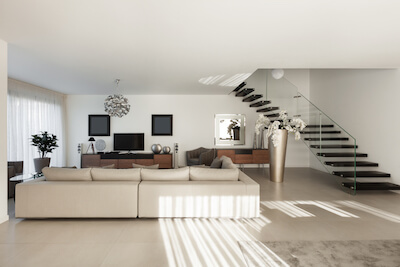Stairs used to be a part of our landscape. They dominated our homes and were used in commercial applications to get from one floor to another.
Modern technology began taking that away, installing escalators and elevators not just in businesses, but in some homes too. While an elevator may seem like a sophisticated fixture in a modern home, reports show that the stairs can help us stay healthy in addition to having access to different levels of a building. One study shows that by climbing 3 to 5 floors a day can reduce their risk of stroke by as much as 29 percent.
All a good reason to bring stairs front and center in your home and your office space.
But stairs do require safety features to keep you out of harm’s way. The National Safety Council indicates that falls are one of the leading reasons people visit the emergency room in the US each year.
While aesthetics are important, safety should also be high on the list when selecting the best option to cover your stairs.
Hardwood
If your home has hardwoods installed both upstairs and down, it may be natural to continue the look to your staircases too. Because stair treads are not that deep – usually no more than 12 inches – hardwood planks offer the best results. You can stain them to match or try a contrasting colored riser to add depth. To make them even safer, attach safety strips designed for use on individual treads.
Carpet
Carpet is one of the safest options. It also offers noise reduction. A carpet’s lifespan depends on the fiber type and how much traffic it sustains each day. A densely woven, low-profile carpet withstands high traffic areas best. You can also mix wood staircases with carpet runners to have the best of both worlds.
Because of safety measures, it’s always a good idea to rely on professional service to ensure your flooring is installed correctly to prevent safety hazards.
If you have questions about changing the looks of your staircase while keeping safety in mind, just ask.
